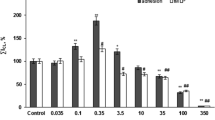Abstract
Nitric oxide (NO) synthesis and free radical generation from polymorphonuclear leukocytes (PMNs) play an important role in several pathological conditions. It is therefore important to understand the regulatory mechanisms of free radical generation from PMNs. Flowcytometry can be used to assess generation of reactive oxygen and nitrogen species from PMNs by using fluorescent probes. In the present study regulation of NO synthesis in the control and lipopolysaccharide (LPS) treated rat PMNs has been investigated. Free radical generation was assessed by flow cytometry using a dye, 2′7′-dichlorodihydrofluorescein diacetate (DCFDA), dihydrorhodamine-123 (DHR) and 4,5-diaminofluorescein diacetate (DAF). Superoxide dismutase (SOD), and catalase significantly attenuated the arachidonic acid (AA, 1 × 10−6 M) induced free radical generation, while 4-aminobenzoicacid hydrazide (ABH), myeloperoxidase (MPO) inhibitor had no significant effect. Intracellular and extracellular calcium levels also modulated FR generation. AA induced free radical generation from PMNs was also enhanced significantly after LPS treatment. NO synthase (NOS) inhibitors, aminoguanidine (AG) and 7-nitroindazole (NI) inhibited arachidonic acid induced free radical generation from LPS treated PMNs, while in control PMNs NOS inhibition had no effect. Augmentation of free radical generation from rat PMNs following LPS treatment seems to be regulated by NO.
Similar content being viewed by others
References
Clark RA (1990). The human neutrophil respiratory burst oxidase. J Infect Dis 161: 1140-1147.
Condliffe AM, Kitchen E, Chilvers ER (1998). Neutrophil priming: pathophysiological consequences and underlying mechanisms. Clin Sci 94: 461-471.
Miles AM, Owens MW, Mulligan S, Johnson GG, Fields JZ, Ing TS, Kottapali V, Keshavarazian A, Grisham MB (1995). Nitric oxide synthase in circulating vs. extravasated polymorphonuclear leukocytes. J Leukocyte Biol 58: 616-622.
Haziot A, Tsuberi BZ, Goyert SM (1993). Neutrophil CD14: Biochemical properties and role in the secretion of tumour necrosis factor α in response to lipopolysaccharide. J Leukocyte Biol 150: 5556-5565.
Kolls J, Yie J, Le Blanc R, Melinski T, Nelson S, Summer W, Greenburg SS (1994). Rapid induction of messenger RNA for nitric oxide synthase in rat neutrophils in vivoby endotoxin and its suppression by prednisolone. Proc Soc Exp Biol Med 205: 220-229.
Boyum A (1968). Separation of leukocytes from blood and bone marrow. Scand. J Clin Lab Invest 21(suppl 97): 77-89.
Sethi S, Singh MP, Dikshit M (1999). Nitric Oxide mediated augmentation of polymorphonuclear free radical generation after hypoxia-reoxygenation. Blood 93: 333-340.
Szucs S, Vamosi G, Paka R, Sarvary A, Bardoo H, Balazs M, Kappelmayer J, Toth L, Szollose J, Single AR (1998). Single cell measurement of superoxide anion and hydrogen peroxide production by human neutrophils with digital imaging fluorescence microscopy. Cytometry 33: 19-31.
Bass DA, Olbrantz P, Szejda P, Seeds MC, McCall CE (1986). Subpopulation of neutrophils with increased oxidative product formation in blood of patient with infection. J Immunol 136: 860-866.
Vowells SJ, Sekhsaria S, Malech HL, Shelit M, Fleisher TA (1995). Flow cytometric analysis of the granulocyte respiratory burst; a comparative study of fluorescence probes. J Immunol Methods 178: 89-97.
Henderson LM, Chappell JB (1993). Dihydrorhodamine 123: A fluorescent probe for superoxide generation. Eur J Biochem 217: 973-980.
Pelt LJ, Zwiter R, Wenlig RS, Roos D, Verhowen AJ, Bolscher BGJM (1996). Limitation of the use of dihydrorhodamine 123 for flow cytometric analysis of the neutrophil respiratory burst. J Immunol Methods 191: 187-196.
Emmendroff A, Hecht M, Matlher MLL, Roesler J (1990). A fast and easy method to determine the production of reactive oxygen intermediate by human and murine phagocytes using dihydrorhodamine 123. J Immunol Methods 131: 269-275.
Bass DA, Parce JW, Dechatelet LR, Szejda P, Seeds MC, Thomas M (1983). Flow cytometric studies of oxidative product formation by neutrophils: a graded response to membrane stimulation. J Immunol 130: 1910-1917.
Kooy NW, Royall JA, Ischiropoulos H, Beckman, JS (1994). Peroxynitrite-mediated oxidation of dihydrorhodamine 123. Free Radic Biol Med 16: 149-156.
Rao KM, Padmanabhan J, Kilby DL, Cohen HJ, Currie MS, Weinberg JB (1992). Flow cytometric analysis of nitric oxide production in human neutrophils using dichloroflouroscein diacetate in the presence of calmodulin inhibitor. J Leukocyte Biol 51: 496-500.
Crow JP (1997). Dichlorodihydrofluoresceine and Dihydrorhodamine 123 are sensitive indicators of peroxynitrite in vitro: implication of intracellular measurement of reactive nitrogen species. Nitric Oxide: Biol Chem 1: 145-157.
Geiszt M, Kaldi K, Szebereryi JB, Light E (1995). Thapsigargin inhibits calcium entry into human neutrophils granulocytes. Biochem J 305: 525-528.
Chiou CY, Malagodi HM (1975). Studies on the mechanish of action of a new Ca+2 antagoinst, 8-(N.N-diethylamino) octyl 3,4,5-trimethyl benzoate hydrochloride in smooth and skelton muscles. Brit J Pharmacol 53: 279-285.
Bei L, Hu T, Qian ZM, Shen X (1998). Extracellular calcium regulates the respiratory burst of human neutrophils. Biochem Biophys Acta 1404:, 475-483.
Greenberg SS, Ouyang J, Zhao XF, Gile JD (1998). Human and rat neutrophils constitutively express neural nitric oxide synthase mRNA. Nitric Oxide: Biol Chem 2: 203-212.
Vosebeck K, Tobias P, Mueller H, Allen RA, Arfors KE, Ulevitch RJ, Sklar LA (1990). Priming of polymorphonuclear granulocytes by lipopolysaccharide and its complexes with lipopolysaccharide binding protein and high-density lipoprotein. J Leukocyte Biol 47: 97-104.
Avidi NJ, Gerwins P, Johnson GL, Worthen GS (1996). Activation of a p38 mitogen-activated protein kinase in human neutrophils by lipopolysaccharide. J Immunol 156: 4867-4875.
Sapira L, Champagne C, Gordon B, Amar S, VanDyke TE (1995). Lipopolysaccharide priming of superoxide release by human neutrophils: Role of membrane CD14 an serum LPS Binding proteins. Inflammation 19: 289-295.
Author information
Authors and Affiliations
Rights and permissions
About this article
Cite this article
Dikshit, M., Sharma, P. Nitric oxide mediated modulation of free radical generation response in the rat polymorphonuclear leukocytes: A flowcytometric study. Methods Cell Sci 24, 69–76 (2002). https://doi.org/10.1023/A:1024197915723
Issue Date:
DOI: https://doi.org/10.1023/A:1024197915723




